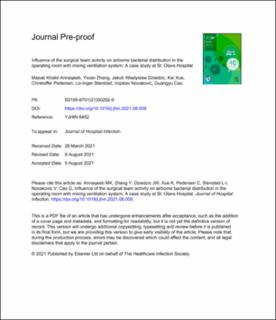| dc.contributor.author | Annaqeeb, Masab Khalid | |
| dc.contributor.author | Zhang, Yixian | |
| dc.contributor.author | Dziedzic, Jakub Wladyslaw | |
| dc.contributor.author | Xue, Kai | |
| dc.contributor.author | Pedersen, Christoffer | |
| dc.contributor.author | Stenstad, Liv-Inger | |
| dc.contributor.author | Novakovic, Vojislav | |
| dc.contributor.author | Cao, Guangyu | |
| dc.date.accessioned | 2021-11-03T08:40:39Z | |
| dc.date.available | 2021-11-03T08:40:39Z | |
| dc.date.created | 2021-08-17T15:53:36Z | |
| dc.date.issued | 2021 | |
| dc.identifier.citation | Journal of Hospital Infection. 2021, 116 91-98. | en_US |
| dc.identifier.issn | 0195-6701 | |
| dc.identifier.uri | https://hdl.handle.net/11250/2827449 | |
| dc.description.abstract | Background Operating rooms (ORs) have strict requirements regarding cleanliness. While existing standards concerning the ventilation and staff guidelines are theoretically sufficient to subvert the threats posed by microorganisms within the room, there exists potential sources of contamination due to human activity around the area. Studies exploring this influence of human activity on distribution of microorganism contamination in ORs have relied on manual observations, or indirect methods such as number of door openings. Aim To utilize depth registration sensing technology to identify the activities of surgical staff and investigate their effect on the distribution of airborne microorganism contamination in ORs. Methods A mock surgical experiment was performed using a depth registration technique for the dynamic capturing of human presence and activity levels. Field measurements were carried out in one real OR to analyze its influence on the bacterial distribution in ORs with mixing ventilation system. Findings: Bacterial contamination levels tended to correlate with higher activity levels, albeit with some inconsistencies. The highest activity levels were around the surgical bed when the patient was placed, and around the instrument table during the surgical procedure. Locations with obstructions had the highest CFU densities, indicating that airflow patterns are important in such spaces Conclusion Our activity monitoring methods demonstrate a novel means of studying the influences of human activities in hospital rooms. | en_US |
| dc.language.iso | eng | en_US |
| dc.publisher | Elsevier | en_US |
| dc.rights | Attribution-NonCommercial-NoDerivatives 4.0 Internasjonal | * |
| dc.rights.uri | http://creativecommons.org/licenses/by-nc-nd/4.0/deed.no | * |
| dc.title | Influence of the surgical team activity on airborne bacterial distribution in the operating room with mixing ventilation system: A case study at St. Olavs Hospital | en_US |
| dc.type | Peer reviewed | en_US |
| dc.type | Journal article | en_US |
| dc.description.version | acceptedVersion | en_US |
| dc.rights.holder | This is the authors' accepted manuscript to an article published by Elsevier. Locked until 14.8.2022 due to copyright restrictions. The AAM is made available under the CC-BY-NC-ND 4.0 license http://creativecommons.org/licenses/by-nc-nd/4.0/ | en_US |
| dc.source.pagenumber | 91-98 | en_US |
| dc.source.volume | 116 | en_US |
| dc.source.journal | Journal of Hospital Infection | en_US |
| dc.identifier.doi | 10.1016/j.jhin.2021.08.009 | |
| dc.identifier.cristin | 1926708 | |
| cristin.ispublished | true | |
| cristin.fulltext | preprint | |
| cristin.qualitycode | 1 | |

